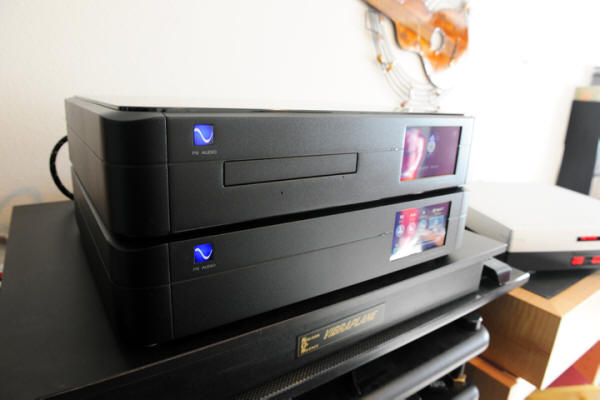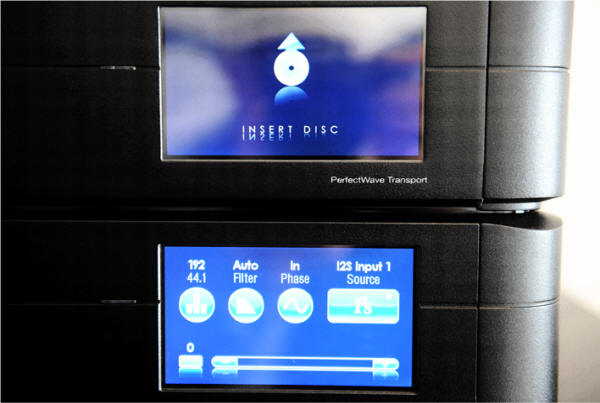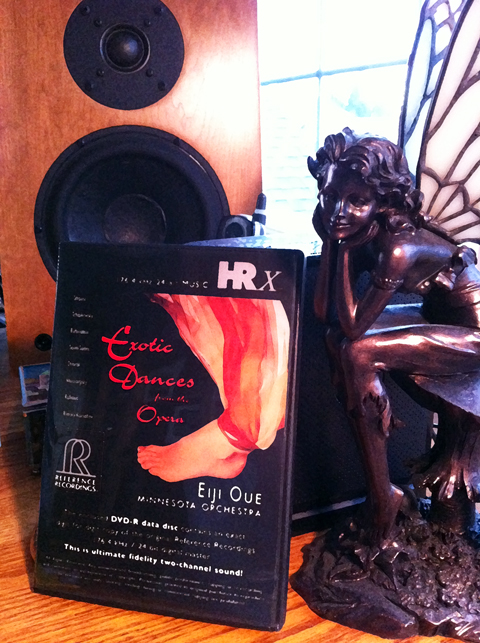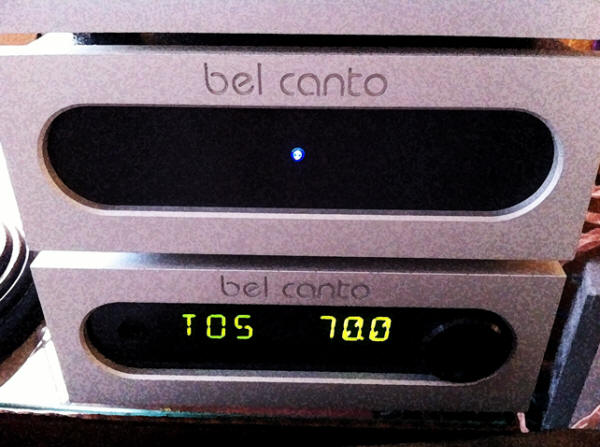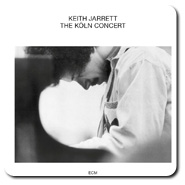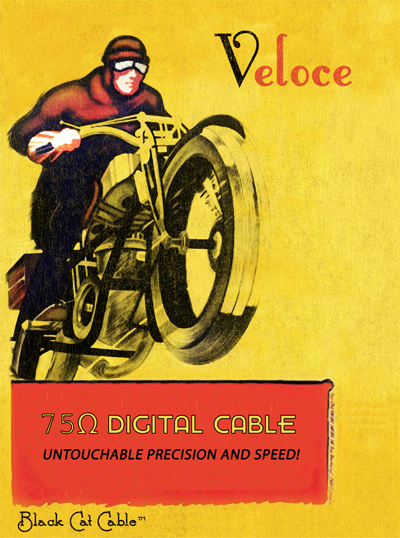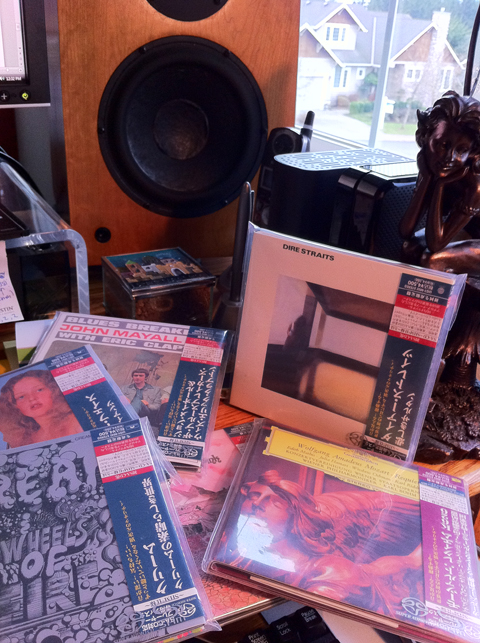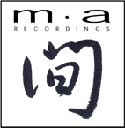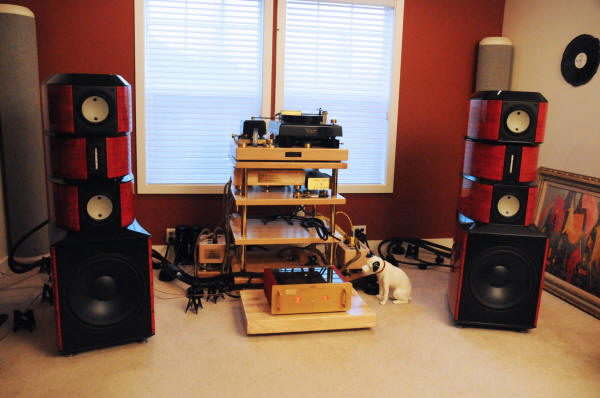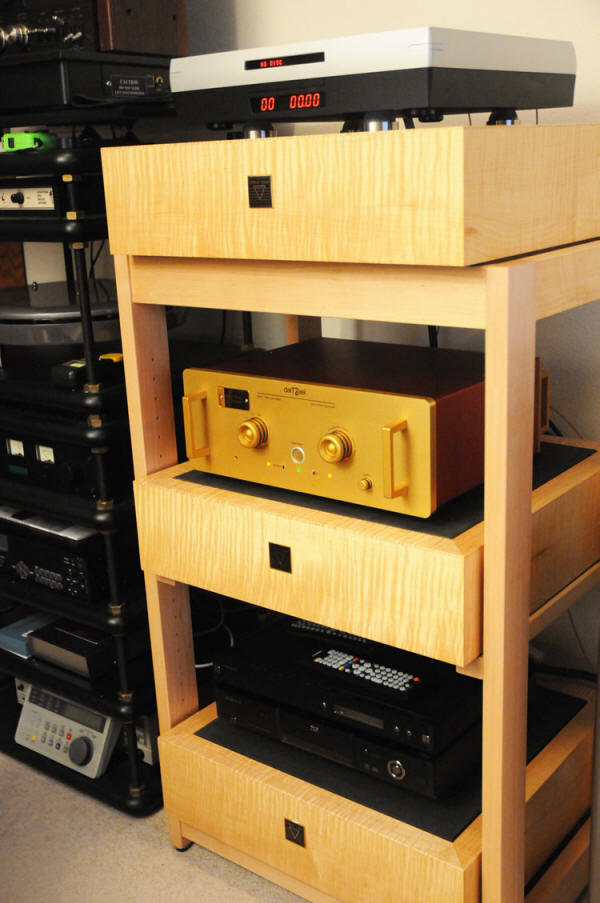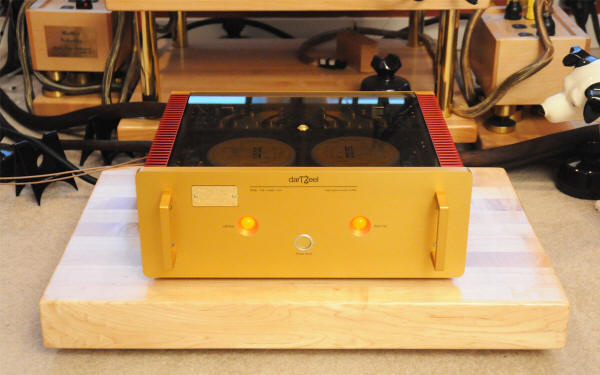|
You are reading the older HTML site
Positive Feedback
ISSUE
52
Robinson's 2010 Positive Feedback Brutus Awards
[All photographs and image processing by Robinson, unless otherwise specified.] Once more, planet Earth completes another transit of its orbit; once again, it's time for me, in medias res, to issue my Brutus Awards for the best of what's been here in 2010. In addition, I'll be giving thought to anyone who might be up for my PF Life Achievement Award, and whether or not I heard anything that lights up a PF Circuitus Maximus Award. (Personally, I'd prefer to be lighting up a great Cuban cigar….) But first, some history: The Brutus Awards were establish back in 2003, when Dave Clark and I decided that the time had come to add PF's voice to the world of audiophile awards. After all, we weren't any less qualified than most of what was out there… heck, in some ways, we had a better take on what was good than some of the dreck that I saw. (Don't take that personally, unless I meant you... you know who you are.) In fact, I stated the rationale behind these awards back when we announced them in PFO Issue 10, December of 2003 (see Issue10). Just to be sure that my readers understand the rationale behind our Brutus Awards, I'll restate what I said then:
In addition, I added my Circuitus Maximus Award in 2009. This is how I introduced it last year:
Finally, there is my PF Gizmo Award, for the best audiomanic of the year, the person who has gone over and above in design, tweakery, and Gizmological Gonzo Gonciousness. Some years I have a person who comes to mind; sometimes none. I do this award to honor my long-time audiobud, Harvey "Gizmo" Rosenberg, gone but not forgotten at this end. That should give you the framework and spirit that these awards are given in. Enough introductions; on to the awards themselves.. Hardware This year was much different from last year. In 2009, there was a boatload of hardware, including some very heavy iron, that was worthy of plaudits. In 2010, much of the focus shifted to computer-based, LAN-based, portable components, and desktop hardware, paralleling a trend that we're seeing more and more in all levels of audio. There was one major exception, which was the Playback Designs/darTZeel/Evolution Audio/Wave Kinetics system… some serious iron here… and which I cover below in our "Circuitus Maximus" Award below.
PS Audio PerfectWave DAC, PerfectWave Transport, and Power Plant Premier
I was able to spend quite a few months this year with some PS Audio gear. This was the first time that I had ever gotten to work with their PerfectWave Transport and PerfectWave DAC. This is a high-resolution (192kHz/24-bit) PCM playback system that I had heard demoed at RMAF 2009, where it sounded quite promising. After several delays in arranging a review set, I finally received a shipment for evaluation.
I stacked the DAC and Transport on my Vibraplane stand, itself placed on my trusty-rusty Michael Green rack. The Power Plant Premier was a couple of shelves below, and was dedicated to the PerfectWave components exclusively. Power cabling and unbalanced interconnects were all Kubala-Sosna Research Elation! Series, which provided exceptional results (see below). I listened via the I2S port, which is recommended by PS Audio, using the supplied PS Audio I2S cable. (The PerfectWave DAC provides lots of I/O, though, including SP/DIF, AES/EBU, USB 2.0, and TOSlink.) Ethernet is aboard to allow the PerfectWave system to talk with your LAN, your wireless system, and eventually with the Internet (with the PerfectWave Internet Bridge and Wireless Dongle). All very cool!
Due to the kind help of Reference Recordings, I was able to obtain a set of their new HRX high-resolution PCM discs for this evaluation project. These are a set of DVDs with 176.4 kHz/24-bit .WAV files, mastered from Keith Johnson's superlative recordings. By the time my evaluation was underway, RR had sent along 14 of their 16 titles to try with the PerfectWave stack. In addition, I did some listening with select CDs, in order to get the feel of Red Book playback. The results were really quite fine, especially on the high-resolution side of the ledger. The HRX discs with their 176.4kHz .WAV files were exceptionally crisp, clear, and detailed. Lots of edge, without edginess, once the system was broken in and fully warmed up. (Allow 100-200 hours for that, based on my experience.) The sound was very dynamic, as you'd expect, with lots of punch. The soundstaging and imaging was certainly more convincing than anything you'll hear with standard Red Book sound. Keith Johnson's work has always been brilliant… he has a natural feel for producing a rich musical tapestry in his work, and he records real music… but unless you've spent a lot of time with his LPs from years ago, you won't have a sense of just how good the RR recordings can be. These 4x the Red Book sampling rate .WAV files (44.1kHz x 4 = 176.4kHz) have a glorious transparency and detail that has to be heard to be fully appreciated. If you prefer PCM sound (some do), then you'll find the crystalline nature of high-resolution PCM files to be quite stellar on the PS Audio PerfectWave DAC. Red Book CD playback is very good, but that's a much more crowded field, especially at the $6000 price range of the PerfectWave stack (does not include the Power Plant Premier, the Bridge, or the Wireless Dongle; contact PS Audio for information on that). You won't buy the PerfectWave stack just to play regular CDs, though; you'll be using it to link up to all of your PCM sources: computer-based, or on your LAN/wireless network, and the Internet. It's the ability of the PerfectWave system to interface with the rest of the digital world, even including the iPhone/iPad as a controlling device, that makes it so bloody appealing. Unfortunately, PS Audio was not able to get me the Bridge or the wireless dongle this time around, and so I am not able to comment on them. Perhaps next time around this will happen. Despite the lack of connectivity gear for actual audition, this is an intelligent approach from PS Audio, is good-sounding stuff, and a clear Brutus Award winner for 2010. Done. And so the PS Audio PerfectWave Transport, PerfectWave DAC, and Power Plant Premier earn a Brutus Award and Ye Olde Editor's "very highly recommended!"
The Cary Audio Xciter DAC [image courtesy of Cary Audio] The Cary Audio Xciter DAC spent 2010 in my desktop reference system doing what the whole new generation of DACs seems to be doing quite well: staying compact, capable, and cool. This 192kHz/24-bit DAC has a combination of a great I/O flexibility (SP/DIF, TOSlink, USB, and BNC), with a continuously variable input selector, with blue LEDs to indicate active input and sync lock for the sampling rate. Outputs are unbalanced only. I hammered the Xciter DAC with everything from CDs to 192kHz/24-bit Classic Records DVD-As (the HDAD series) from my Oppo Digital BDP-83SE's SP/DIF output via the excellent Black Cat Veloce 75 Ohm digital cable (see below). I also used my Dell Precision T7400 workstation (QuadCore @ 3.2gHz with 4 GB RAM and 15K SAS hard drive array) to drive TOSlink at 96kHz/24-bit from hard disk-based .FLAC files from HDTracks and HQM Store (more below on both of these high-resolution download sites) in Windows Vista Ultimate using Winamp as the playback application. (Handles 96/24 .FLAC files in Vista very nicely, by the way.) My new HP Pavilion DV8 notebook computer with i7 processor and high-speed SATA hard drive array allowed me to use Windows 7 Ultimate's Windows Media Player 12 to send high-quality USB 2.0 output at 96/24 via both the Locus Design Group's truly outstanding Cynosure USB 2.0 audio cable, and Nordost's less committal, but still engaging Blue Heaven USB cable. In other words, I worked out every one of the digital inputs extensively over a number of months. The results were excellent in every case. The Cary Audio Xciter DAC was always smooth, musical, and unfatiguing in its presentation of the music. And I should know: I spent countless hours listening to the results, as I pounded the keyboard in my office and listened in nearfield via the HeadRoom Desktop Reference System and a pair of very nice Harbeths. (See my full review in PF Issue 46 for details of that system, at Issue46.) This is an external DAC that can be used for all sort of settings, but I can vouch for its stellar performance in computer desktop settings. At only $1499, the Cary Audio Xciter DAC is a ton of great listening for a relatively moderate mound of moolah. Highly recommended! And the recipient of a 2010 Brutus Award, to boot. It earns a Ye Olde Editor's "highly recommended!"
Bel Canto e.One DAC 2.5 Integrated Processor and REF150 Stereo Amplifier The Bel Canto e.One DAC 2.5 Integrated Processor (lower unit) and e.One REF 150S stereo amplifier (upper unit) One of the later arrivals to the desktop reference system this year was Bel Canto. The HeadRoom Audiophile Desktop Reference system went out with one tide; the Bel Canto e.One DAC 2.5 Integrated processor (MSRP of $1995) and REF 150S ("S" for "stereo"; MSRP of $1495) amplifier floated in with the next. The Ref 150 is rated at 75 Watts maximum per channel @ 8 Ohms, and 150 Watts maximum per channel @ 4 Ohms. In the world of real listening, 120 Watts and 60 Watts respectively are more like it, and sound like it here. Note that this is a Class D design, with switching power supply) replaced the fine electronics from HeadRoom and Cary Audio. The Scanspeak-based Nova Ovation monitors (88 dB/Watt/meter; nominal 8 Ohms, with a minimum of 6 Ohms) stepped in for the Harbeths, a net gain as I sit and listen to them, even at this moment (Keith Jarrett's Koln Concert in 96/24, purchased over at HDTracks, in case you're interested).
I must remember to say that I did attach my Townshend Audio Supertweeters to the Ovations, which give me a high end that approaches 90kHz. The sense of increased spaciousness and detail in the nearfield is noticeable, and mates well with the Bel Canto e.One system. I rounded out the Ovations with two Walker Audio Resonance Control Discs, just to keep the Ovations in line. They're solid speakers, but I don't want any loose cabinet resonance in the mix. So far, so good; they're sounding great, with rich, harmonic tone…like a musical instrument. Which is as it should be.
The cabling at the current time is a combination of the bloody wondrous Kubala-Sosna Elation! unbalanced interconnects, Black Cat Veloce 75 Ohm coax digital, Nordost Blue Heaven USB 2.0 cable, and various JENA Labs power cables, interconnects, and speaker cables. The sources are the same as listed above in my section on the Cary Audio Xciter. The two components are directly hooked up via XLR from the DAC 2.5 to the REF 150 S. (I'm using JENA Labs XLR now; later, I'll try the Kubala-Sosna Research XLRs.) If you do it this way, you get maximum control and system synergy, according to Bel Canto's manuals. Having heard it, I can believe it. In the weeks that I've had the Bel Canto e.One DAC 2.5 and REF 150S in place, I can say that they've won me over quickly with their dynamic and rich musical performance. I thought that the HeadRoom Reference electronics would be a tough act to follow, especially in the nearfield. In fact, I hesitated for a bit to make the switch, simply because I had enjoyed the HeadRoom system so very much, but I needn't have worried. The Bel Canto gear has surprised me very pleasantly, and very quickly. The REF 150S never poops out on driving the Nova Ovations… I had wondered about that, since 88 dB/Watt/meter is middling for efficiency. Some audiophiles have a bias against Class D amplifiers, but I'm not hearing any of the stereotypical old-time Class D sins. I don't hear any lightness in tonal balance, no bleaching of the sound, no grain, nor any edge, and no sense of harshness. I think they like Scanspeak drivers quite a lot… in fact, so have I, and for quite a long time. The e.One DAC 2.5 has shown itself to be a very capable performer, handling everything from 44.1kHz CDs all the way to 192 kHz/24-bit without a click, pop, or problem. There is, in addition, an unbalanced analog input, that behaves itself nicely and does very well with the analog signal that I've been tossing its way from the Oppo BDP-83 SE dedicated stereo analog outputs. This give you maximum flexibility for mixed sources… though I have to say that I wouldn't have minded a second set of analog inputs. There is a shuttle wheel on the face of the DAC 2.5 to handle input switching and volume manually, but you don't need it. The handy IR remote control uses a nice wide-scatter pattern, so that I can control all DAC 2.5 functions by bouncing the beam off closet doors and wall…very handy. It features remote control of volume and source, naturally, but also has two-step muting (soft mute and total mute), the usual gang of CD function controls, a mono toggle, balance, and even a phase control (not all DACs include this). Thus far, no bad habits, completely reliable, and great prices on both components. This is another winner, and it didn't take too long to put it on the list. The Bel Canto e.One DAC 2.5 and REF 150 S have already become favorites of mine. If you're looking for great sound in compact, light, and cool-running form factors, with excellent energy efficiency, you'll have to give the Bel Canto e.One's a really serious listen. This is the real thing. It hereby earns Ye Olde Editor's "very highly recommended!" and a Brutus Award for 2010.
Kubala-Sosna Research Elation! Series Interconnects and Power Cables
The Elation! unbalanced cables in action, wowing yours truly right out of the box! You know, while I get a lot of offers to evaluate cables, it isn't too often that I: 1. Actually do it, life being far too short; and, 2. Am impressed by the results. (See #1 above.) My list of the "truly righteous wire" that I've evaluated in my own listening room and fallen in love with is pretty short over a lot of years. The names include Cardas, JENA Labs, Omega Micro (though that last can be tricky to deploy and deal with), Stereovox, Silent Source, Evolution Acoustics, Black Cat (see below), Furutech, and DH Labs (HDMI). That's not to say that there aren't other great designs out there; it's just to say that most of them haven't made it here, and I only have so much time for serious evaluation of cables. Cable evaluation takes some time and effort. So, I don't spend much time seeking out cable projects. But this year, I had two different cable projects come to me. This one was from a new audio friend, Joe Kubala of Kubala-Sosna Research. PFO has given good coverage to Kubala-Sosna over the years, but I wasn't personally acquainted with their sound, apart from the occasional exposure under show conditions. Last year, Joe and I had a chance to meet, and to talk for quite a while at the 2009 annual meeting of the Los Angeles/Orange County Audio Society. As it turns out, both Joe and I have a powerful love of fine photography, in addition to our passion for fine audio. Joe is a gifted photographer in his own right, and so we hit it off, and passed a couple of hours in a splendid discussion of the f/64 Group, various formats, new possibilities in digital photography… a great time, with a kindred fellow! The upshot was that I determined to try the Kubala-Sosna Research cables for myself. Joe was kind enough to send along a set of his top-of-the-line Elation! cable line, which I am deploying piece by piece into the listening systems here. I have some of the unbalanced, some of the balanced, power cables, and speaker cables in this line. The plan is to start out small, and work my way up to a complete set. This way I'll develop a feel for what the Elations really do at each step of the way. Thus far, I've tried his 20 amp Elation! power cables, and the Elation! unbalanced interconnects. (In fact, the Elation! power cables are connected to the Bel Canto e.One DAC 2.5 and REF 150 S right now, as I type.) They are substantial in build… closer to hose-like than to willowy… with a very attractive silver mesh outer jacket. Be warned! These cables will not be the sort of thing that you'll try to fish through tight corners or delicate cable junctions. Work with them, plan your cable layout, and you shouldn't have too much difficulty, though. Thus far, I have hoisted them carefully into place in three different settings, with more to come. I expected to have to wait for a week or two for the sound to begin to settle down. There's no shame in that; it's very common in high-end cabling, especially at the reference level. But then… Zounds! Right out of the box, the Elation! unbalanced interconnect and power cables jumped right to the front rank of what I've heard, under conditions that I know very well. No long… sometimes excruciatingly long… break-in period. Within moments, the Elation! was ready to go, and blooming rapidly. That is not a common finding. The music was well detailed, but not documentary; there was warmth, without romanticism; the recordings were harmonically rich; dynamic without violating a natural sense of rhythm. Transient response also struck me as very natural, with no ringing or overshoot. These cables are fleet of foot, but also fundamentally right in presentation of music in a natural soundstage, filled with ease and grace. That key indicator, connecting with the music emotionally, is here in plenty. These cables are not cheap, amigos… on the contrary… but if you can stand the price, the K-S Elations will deliver the goods. After spending a couple of months with the Kubala-Sosna Elation! cables, I'm ready to give the unbalanced interconnects and the power cables the plaudits they deserve. Having heard these cables for myself, I am quite convinced that they are front-rank world-class designs. Top 'o the heap. Bloody fine. Hale fellow, well met, and cheers! I therefore give the Kubala-Sosna Research Elation! line a Brutus Award for 2010, and Ye Olde Editor's "Very Highest Recommendation!" with real enthusiasm.
Class, pay attention. Black Cat Veloce 75 Ohm Digital Cable
One other cable arrived this year, from another good audio friend, a person whose work I've respected all the way back into the 1990s. Chris Sommovigo sent along to me his new Black Cat Veloce 75 Ohm digital coax (with coax-to-SP/DIF adapters). They were a new affordable line, and he really wanted me to check them out. He had put a considerable effort into designing and producing them, they had ultra-high bandwidth…gigs and gigs…and he thought they were outstanding at their price point. "How affordable?" sez I. "Oh, what would you say to factory-direct at $123 per 1.23 meter lengths?" "Holy Hootchee-Kootchee!"
As it turns out, he was right. About the price…and about the performance. The break-in time was minimal… just a few hours… and I've been using them for SP/DIF ever since: first on the Oppo Digital BDP-83 SE to Cary Audio Xciter DAC interface, and then on the BDP-83 SE to Bel Canto DAC 2.5 interface ever since. I've run these all the way out to 192kHz/24-bit on a regular basis, listening in nearfield via both Harbeth and Nova Ovation monitors. The results have been consistently excellent. Everything from Red Book to high-resolution PCM has been delivered at very high levels, with speed, detail, and pleasant musicality. No complaints at all; the Veloce delivers high quality all day long. In fact, this is the best that I've heard in SP/DIF cables at this price point. Not only that, but the Black Cat graphics are some of the coolest that I've seen… light years away from dull and boring! So, give the Black Cat Veloce75 Ohm digital cable a Brutus Award for 2010, as well as a Ye Olde Editor's "highly recommended!"
JH Audio JH16 Pro In-Ear Monitors This one is short and sweet. As I commented in my Audio Oasis! Awards for RMAF 2010 (see elsewhere in Issue52.), I had my second encounter with Jerry Harvey and the good folks at JH Audio in the CANJAM space at the 2010 Rocky Mountain Audio Fest. For the second time I checked out their reference "in-ear monitors," as they style them. Last year it was the JH13 Pro's; this year, I caught their new JH16 Pro model. I recorded my initial post-show impressions in the report above. My experience with the JH16 Pro's since then have confirmed that these are very special in-ear devices. With double dual-low drivers, single dual mid drivers, and single dual high drivers, integrated three-way crossover network, and an in-ear rated frequency response of 10Hz to 20kHz, your ears won't die of sonic thirst. Certainly, they have put other in-ear devices that I've used to shame, and by a country parsec. With the growing ubiquity of portable music of reasonable quality, and the amount of traveling on jets (and waiting in bloody airports!) that I do, the JH Audio JH16 Pro's are making a major difference in my enjoyment of my iPod 5.5, iPhone 4, and computer-based music on the road. Being custom fitted to my ear canals, the JH16 Pro's are comfortable for longer-term listening. They also seal out a huge amount of background noise in jets, allowing me to listen at comfortable levels with the volume turned down significantly, compared to my prior levels with other in-ear buds. In fact, they're so good that I'm going to do a follow-up evaluation of the JH16 Pro's with a new portable amp design from Ray Samuels Audio. We'll see how that turns out in 2011. $1149 is the baseline price. That isn't cheap, but if you're looking for topnotch quality in portable audio, this is the place to go for in-ear monitors, amigos. A 2010 Brutus Award to JH Audio, then, along with a Ye Olde Editor's "very highly recommended!"
Recordings/Recording Companies SHM SACDs
The production of high-quality SACDs was augmented quite nicely this year by the arrival of SHM SACDs from Japan. SHM ("Super High Material") SACDs are made by Universal Japan from a special "high quality polycarbonate material originally developed for LCD panels," and not from the usual stuff. Universal Japan claims improved optical transmission properties for their SHM SACDs using this materials technology. Audiophiles in Japan are claiming to hear improvements in presence and musical detail with the SHM SACDs. More on that in a moment. There was a bit of a dust-up a while back over on Audio Asylum's Hi-Rez Highway (SACD discussion group) about the sources used by Universal Japan for the SHM SACDs. Were these pure DSD masters from the original analog sources? Or were the signals passed through some sort of bollixed PCM processing for audio auto-eroticism by the mastering engineer? Provenance and mastering processes are of extraordinary interest to audiophiles and collectors alike, especially at the price level involved. According to Universal Japan, the SHM SACDs were made from DSD masters produced between 2002 and 2004 and held in their archives, with some titles mastered to DSD in 2010. This makes sense to me, as I'd guess that the titles stockpiled between 2002 and 2004 would have been the recordings that the Universal Music Group was stacking up for SACD reissues, before Sony tripped over its own body part regarding SACDs, and the rest of the world played "follow the 'leader.'" (Idiots. Who pays these people to make such foolish decisions?) The 2010 DSD transfers are for this project, obviously, as Universal Japan does this project for the audiophile SACD market. Smart move: limited editions, done to audiophile standards for mastering, packaging, and A&R that catches the eye for jazz, classical, and particularly rock and roll. Nota bene! This is a purist product, clearly. These are not hybrid discs… there is no Red Book CD layer at all, since there are those who believe that the CD layer slightly degrades the sound of the DSD layer on a hybrid disc. (I'm going to do some checking on this claim in 2011 with some new comparison discs.) No, these are pure stereo-only, DSD-only discs. That cuts the licensing and production costs, naturally, but the meticulous care put into the liner notes, and the exemplary packaging, eats up some of the savings. I assume that the SHM material and process itself likely adds to the production costs, especially in these limited-edition quantities. That's why you'll pay in the neighborhood of USD $50 a pop for these limited edition titles. By the way, lest I get the obnoxious email or two from the tiresome Cost Cops: yes, USD $50 or so per title, depending on the exchange rate between the Yen and the Dollar on any given day, is a fair amount of money. Then again, $50 for limited audiophile-quality LPs, especially the 45 RPMs, has become pretty commonplace for years now. And these SHM SACDs are purist single-layer analogue-to-DSD discs. If I were you, I'd short-circuit the arguing, and put some bucks into acquiring a few of these. You snooze, you lose. Unless Universal Japan makes the decision to re-license… that would be a good thing… present inventory is what we'll have. The quality of the sound is really quite fine. I've spent several months with an ever-growing pile of the SHM SACDs. Thus far, my ear isn't yelling at me that there's a pile of nasty PCM in the chain… in fact, I'm listening to Caravan's In the Land of Grey and Pink right now. It's become a big-time favorite of mine, bringing back memories of the late '60s and early '70s. Creative stuff! The thing that I'm especially enjoying with the SHM SACDs is the rock 'n roll A&R. Some of these reissue titles are predictable (e.g., Police Synchronicity and Outlandos, Eric Clapton's 461 Ocean Avenue), though they are excellent remasters, but many others are a first-time delight! Check out the Caravan title listed above, or any of the following:
Dire Straits, Dire Straits Toss in some Kiss, some Black Sabbath, some more Clapton in various guises (Derek and the Dominoes, etc.), some Rolling Stones, some Rod Stewart, some Gentle Giant, Fairport Convention... well, you get the idea. Terrific A&R! Some real music! And a quiet extension of the very promising rock 'n roll reissues from UMG that were aborted when the clueless wonder powers-that-be decided that dementia was the better part of valor. (And at the very point that SACDs were beginning to get traction in the marketplace!) Frankly, I don't mind if these are coming late and in limited editions, courtesy of Universal Japan. (Kudos to this fine group!) I'm telling you that you should jump on these immediately, while you can! This is rare stuff, and fine-sounding, and some terrific music. The jazz and classical reissues are also sounding fine to my ears. I've brought in titles like the obligatory Getz/Gilberto, Miles Davis (Relaxin'), Sonny Rollins Saxophone Colossus, some Wes Montgomery, some Art Pepper… good stuff all, sounding like clear and clean DSD transfers from analog, unless somebody's been doing magic with PCM of late. (Doubt it.) I've been more selective with the classical reissues, since I have a very large collection of classical SA's. Thus far, having listened to titles like the Mozart Requiem (Bohm), Bach's Orchestral Suites 1 & 2 (Richter), Symphonie Fantastique (Sir Colin Davis) and Beethoven's Ninth (Ozawa). All sound very fine: detailed, rich, and generally well layered in their soundstaging, though this varies from label (Decca) to label (Deutsche Grammophon). Enough said; those of you who know the difference between those two labels know what I mean. By the way, Universal Japan is continuing its series of reissues into 2011, with two sets already announced for January and February. More great music is comin', chillens! For those of you interested, you can find these at very good prices at Eastwind Import, hosted by good fellow Hajime Sato. Eastwind Import is an online music store established in 2006 by its jazz fan/audiophile owner. Eastwind is based in southern California; the company imports hard-to-find Japanese jazz CDs and LPs and distributes them all over the world. I note that Hajime has since then expanded his business to include audio gear, representing select brands such as Musical Heart Instruments (MHI), Cable Research Lab (CRL), Dynastrand, and the Silicon Arts Design Si2 Micro Integration Line. That last won a 2010 PFO Writer's Choice Award, so it's definitely good stuff, and I don't mind giving Hajime a friendly plug. He's very helpful, and knowledgeable about music and his inventory; USA readers should give him a shout. Website: www.eastwindimport.com Email: [email protected] Tel: 714-334-0759 These SHM SACD titles are also carried by Chad Kassem at Acoustic Sounds, though at higher prices than Eastwind: check out http://store.acousticsounds.com/s/284. For our readers in Asia, you can directly to cdjapan.co.jp to order these fine discs. http://www.cdjapan.co.jp/popular_formats/SHM-SACD/index.html Good stuff! And definitely worthy of a 2010 Brutus Award and a Ye Olde Editor's "highest recommendation!"
Analogue Productions Blue Note and Nat King Cole Reissues: SACD and LP This one is short and sweet: if you haven't picked up every one of the Blue Note and Nat King Cole reissues from Chad Kassem and company at Acoustic Sounds, you're really missing out! Absolutely brilliant mastering, with oversight by Chad the K, leads to top o' the heap SACDs and LPs. Pick vinyl/SACD… whatever your budget can stand… and have at it! Enough said. A 2010 PFO Brutus Award for Analogue Productions, with a Ye Olde Editor's "highest recommendation!"
Reference Recordings SACDs and HRx discs (.WAV)
Keith Johnson and company have been doing fine work at Reference Recordings for a number of years. I have a pile of RR LPs and CDs in my music library here. Heretofore, the LPs were the best way to hear Keith's excellent recordings. The CDs were good (for CDs), and the HDCDs were somewhat better (for enhanced CDs, which was no surprise since Keith led in the development of that enhanced CD standard back in the '90s), but neither had the superior sound of the LPs. This is also no startling realization. But now, something new has been added. RR is releasing a series of high-resolution discs in two different formats: stereo 176.4kHz/24-bit .WAV, which RR says is a "digit-for-digit copy of the original Reference Recordings... digital master." The sound of the HRX discs is quite a major step forward for RR, clearly clobbering either of the earlier CD formats as auditioned through the PS Audio PerfectWave Transport and PerfectWave DAC over a period of a few months. I listened to fourteen of the 16 titles now listed on the RR site, and found the difference to be quite sparkling. No Reference Recording CD or HDCD could stay in the race with the 176kHz/24-bit .WAV files on the HRx discs as auditioned with our reference-grade system in the main listening room (see the Circuitous Maximus Award below). No contest. End of discussion. The superiority of the 4x sampling rate and the larger word length simply leaped out at me, possessing more of the audio virtues that I associate with pure DSD recordings: soundstage depth, specificity and precision of imaging, and remarkable dynamics. Via the PS Audio PerfectWave stack, this was more like it! Clearly, if you want PCM discs that give you a real sense of what a master recording engineer can do with the 176.4kHz/24-bit format, then the RR HRx discs will do that for you. I should also mention that I have all three of the RR SACDs as of this date on hand for evaluation (the Oue Exotic Dances, the Tutti Orchestral Sampler and the SACD of Britten's Orchestra, which I'm listening to right now). I have no doubt that Keith Johnson would disagree with me here, but I prefer the sound of the SACDs to the .WAVs in our reference system. For example, I found the SACDs to have a greater sense of ease and spaciousness, and a bit less of the edge on brass and percussives, without losing the dynamics. To my ears, the front-to-back soundstaging was also better on the SACD of Exotic Dances than on the HRx. I would guess that Keith would find this to be hard to accept, since the original files on the HRx discs are "digit for digit" copies, and how can any transition to another format, as in 176kHz/24-bit PCM @ 2.8224mHz DSD be anything other than a compromise? That's a good question. But I can only call 'em like I hear 'em. Personally, I suspect that DSD is doing some things that are fundamentally right, and that even PCM masters can be improved by shifting to this alternative encoding and transport, but I freely confess that to be speculation. Now in all fairness, some portions of the differences may be due to a mismatch between PS Audio PerfectWave stack and the Playback Designs MPS-5 SACD/CD player; after all, I consider the MPS-5 to be the best SACD/CD player that I've heard, and I am not alone in that evaluation. In addition, there is a substantial price differential between the two designs: the PerfectWave stack retails at a few pennies under USD $6000, while the MPS-5 tips the balance beam at a cool USD $15,000. Nevertheless, there aren't many optical playback options for HRx discs in their native format and resolution, and so this was the best that we could do for the evaluation under the time constraints of the evaluations. (We do have computer-based playback options in Windows 7 Ultimate with an Intel i7 processor and 4 GB RAM, since Microsoft's Windows Media Player 12 will play back the 176.4kHz/24-bit .WAV files without a problem. Unfortunately, Microsoft has throttled PCM output via USB 2.0 and TOSlink at 96kHz/24-bit at the current time, which prevents me from leveling the playing field via hard-disk playback at full sampling rates.) RR itself recommends loading the HRx .WAV files onto high-end music servers with the requisite high capacity hard drives, processors, and (especially) very high quality sound cards that can output to first-rate DACs. That's an excellent idea; it's the best way to get the most out of these .WAV files… at least, until something better comes along. Regardless of these considerations, the Reference Recordings HRx discs are a signal accomplishment, and computer-based audio is making substantial progress towards realizing the promise of the high-resolution .WAV format. We'll continue to be using optical discs in the interim, especially for users in low-bandwidth settings (up to 4.7 GB for a single HRx disc is a significant data payload for all but the fastest connections), but playback is getting much better. And I think RR deserves a salute for the quality of these stellar discs. Therefore, I give Reference Recordings a 2010 Brutus Award for their HRx discs and Keith Johnson's superb recordings, with a Ye Olde Editor's "very highly recommended!"
HDTracks
Short and sweet: I gave David and Norman Chesky and company a Brutus Award in 2009 (see Issue46) for "their innovative Internet-based system for downloadable high-resolution (88.2kHz/24-bit and 96kHz/24-bit) recordings." So what's changed that I would repeat this Brutus Award? Well, the online system is pretty much as it was, but the availability of high-resolution music has literally exploded over the past year. The number of really great artists and excellent recordings that are now available in 88.2kHz/24-bit and 96kHz/24-bit is much larger now, with major and minor labels joining all the time. I've done some purchasing and downloading over there this year, and have enjoyed every minute of it. I said this in 2009: "If you have a yen for great high-resolution recordings from a bucket-full of excellent labels, have a high-speed Internet connection, some serious hard disk space, and a music playback system that will handle .FLAC files (Windows Media Player 11 and Apple iTunes do NOT support this format natively), then HDTracks is going to help you with your audio jones, big time." The only changes that I would make to that evaluation is that the number of labels is much larger, and that Windows Media Player 12 in Windows 7 still doesn't support .FLAC natively. Neither does Apple. I've found that Winamp does the job nicely, however, and can be downloaded for free (the Pro version is around $20), those fine fellows. The results are very encouraging. So, for continuing to maintain high-resolution standards in a world generally gone to the audio compression dogs, and for expanding the pool of available labels, my hat is off to the Chesky's and to HDTracks again in 2010. Here's a 2010 Brutus Award to HDTracks, and Ye Olde Editor's "very highly recommended!"
MA Recordings
If HDTracks is operating at a larger enterprise scale, and deserves a repeat award for quality, I must do likewise for Todd Garfinkle of MA Records. I gave him recognition in 2009 by saying "Todd's willingness to essay high-resolution audio recording in 5.6mHz DSD format is also worthy of the highest praise. MA Recordings is also exploring 96/24 DVD optical discs, the new DSD Disc format (see my article on the RMAF 2009 panels elsewhere in Issue46 for more on the DSD Disc format), as well as .WAV format in 176.4kHz." Todd has continued his work with a set of superb Double-DSD (5.6mHz) recordings in 2010, with DVDs available of his recordings at 88.2kHz/24-bit and 176.4kHz/24-bit PCM. I'd love to see more of Todd's recordings in SACD, but the production costs associated with SACDs have limited his output in that optical format. In the near future, I am hopeful that we will see this distribution bottleneck disappear for DSD recordings (details when available!); in the meanwhile, Todd's DVDs sound tremendous on computer-based playback, even with the additional Microsoft 96/24 bottlenecks on USB 2.0 and TOSlink throughput. The passion and quality in Todd's work at MA Records has led to recordings of remarkable ease, naturalness, and audio purity: check out his 176.4kHz/24-bit DVD Puente Celeste Nama, or Llama in 88.2kHz/24 bit, or a particular favorite of mine, the J. S. Bach 6 Suites a Violincello Solo senza Basso, Volume 1 (covers Suites 1-3). This is exceptional work, accomplished by a master recordist with a natural feel for what is natural. So for the second year in a row, I must recognize Todd Garfinkle and MA Recordsings with a Ye Olde Editor's "very highly recommended!" and a 2010 Brutus Award.
Circuitous Maximus Evolution Acoustics/Playback Designs/darTZeel/Wave Kinetics
The stellar Evolution Acoustics MM2 loudspeakers, with the darTZeel NHB-108 Stereo Amplifier on a Walker Audio Prologue Reference Amplifier Stand Finally, there is my award for system synergy in my listening room during this year. I launched the Circuitous Maximus in 2009, believing that I needed to have a category for superior system synergy when this occurred. Last year I said, "I have a new award that I am going to launch for 2009. This will be the PFO Circuitus Maximus Award. It will only be given when I've encountered multi-component systems that exhibit the very highest level of reference-grade synergy. Since that happens only once in a while, some years may see no Circuitus Maximus awarded at all." Last year was a bumper crop year for system synergy, and I recognized both mbl and Boulder Amplifiers for their superlative qualities in this regard.
The Playback Designs MPS-5 SACD/CD player (top) with the darTZeel NHB-18NS Preamplifier (middle) on a Critical Mass Systems Grandmaster Black Component Rack This year saw the same loudspeakers, but with a different chain of electronics and support components: the Playback Designs MPS-5 feeding the darTZeel NHB-18NS Preamplifier. This tandem then sent the signal downstream to the darTZeel NHB-108 Stereo Amplifier, which in turn sent it along to the Evolution Audio MM2 loudspeakers. Isolation feet by Wave Kinetics were used under the MPS-5 (model A10-U8) and the MM2's (model 2NS), with a noticeable improvement in sound in both places, carefully noted by some rather arduous A/B comparisons, back and forth. (Frankly, if I had more of the A10-U8 isolators, I'd put them under the preamp and amplifier, as well.) Cabling is by Evolution Audio, with PC2 One power cords to the MPS-5, the NHB-18NS preamp, and the NHB-108. The speaker cables are the Evolution Acoustics DRSCs. The only exception on the cabling is the fact that two of the very fine Silent Source power cables were used for the powered woofers on the MM2s.
The new darTZeel NHB-108 Stereo Amplifier on its Walker Audio Prologue Reference Amplifier Stand, with much stiffer performance than in past years… Both the mbl reference system and the Boulder Amplifier components were extraordinarily synergistic, each in its own way. Both were very tough acts to follow. How would this chain of components do by comparison in 2010? Jonathan Tinn of Blue Light Audio worked with me to assure optimum measured linearity of frequency response in my listening room. We used several different sonic analyzers to dial in the MM2's for dynamically flat response in place, cross checking the results, which turned out to be reassuringly stable over time. Listening sessions took place at levels that ranged from volumes in the 80's of dBs to as high as 105-110 dBs (for short crescendos and dynamic peaks… I do treasure my hearing, after all!) This was impressive, as a revision of the darTZeel NHB-108 from years ago would sometime clip at these levels. The revised model was still 100 Watts per channel, but was definitely stiffer in its performance, and spent the entire year simply doing the job without clipping or cutting out. This is an excellent result all by itself. The NHB-18NS preamplifier is simply a jewel in every sense of the word. This particular unit has two MC phono inputs installed, providing 63 dB of gain quite flawlessly. The virtues of the Ortofon A-90 on the Continuum Criterion shone, day in and day out. I've certainly never heard a better phono amp integrated within a preamp. The line-level input from the MPS-5 SACD feeds were to die for: simply glorious, and setting an obvious standard for preamp transparency and dynamics. It embodies that audiophile dream: the preamp that give you gain without pain. It steps out of the way of the signal, and leaves no flavor on the audio signal that I could qualify. Very, very neutral; very "not there." Exceptional. And the MM2's… well, in a room of my size, they were as authoritative, and yet as uncolored as anything that has ever been here. The frequency response was definitely below 20Hz someplace; in a larger room, it would be interesting to see how low it would go. Below 16Hz? I suspect so. And the playback was always wonderfully integrated, with no sense of "here's a driver, and there's another, and I can pick that one out, too." I'd simply close my eyes, and listen, and there it would be: Stevie Ray Vaughn, or Duke, or Miles, or Creedence Clearwater, or Reiner and the CSO…. I've never heard better here. This is no quickie conclusion, mind you. Having spent the past year listening to literally hundreds of hours of music through this system, with various sources in place (Walker Audio, Continuum, Playback Systems, and PS Audio), I'd have to say that the Playback Designs/darTZeel/Evolution Acoustics/Wave Kinetics combination is as incredibly synergistic as anything I've ever heard. Nothing gets in the way of anything else; everything seems to breathe and live as one, and to do so effortlessly. The quality of the audio reproduction is startling. The transparency of the sound is my current zenith; no hum or background white noise, yes, but also no blurring or romanticizing of any source that I played through the system at all. And I put enormous amounts of music through the pipeline: hundreds of SACDs (that's no exaggeration, by the way—we have over 3500 SACDs in our reference library here), LPs, HRx .WAV discs, CDs... they all made their way through the playback chain. In no instance was the result anything other than top of the heap. When you consider that darTZeel and Playback Designs/Evolution Acoustics/Wave Kinetics are different companies, as are Walker Audio, Critical Mass Systems, and Silent Source Audio, the extraordinary degree of fusion that has lived here for a year is truly amazing. If you are looking for world-class audio reproduction that is intensely synergistic, I suggest that you take a very careful look at the winners of this year's Circuitous Maximus Award. It is going to be very hard to top the 2010 winning combination. I wouldn't be surprised if I have to wait a while to find anything nearly as good. And perhaps quite a while. This combination of components therefore wins the 2010 Circuitous Maximus Award, with a Ye Olde Editor's "very highest recommendation!"
Gizmo Award
When I first launched the PFO Gizmo Award in 2003, I said this about it: Long-time readers of PF and PFO know that Harvey Rosenberg (AKA "Gizmo") was a close friend of mine, and a valued member of the PF writing community for a number of years. His untimely death a couple of years ago was a real blow to fine audio, the loss of a uniquely creative writer. In Harvey's memory, we have created an annual award that (like Harvey!) will be unique: a one-only-per-year recognition of a person/design that is surfing the edge of audiomania, going all-out to push the frontiers of fine audio. There will be no multiples of this prize… no hard-and-fast categories… and if nobody floats our boat in a given year, it won't be awarded. In 2009, I gave my Gizmo Award to the extraordinary audio designer, Jennifer Crock, and well deserved it was, too. This year, no name comes to me as I've thought about the Gizmo. One name was close, but I want to think about it for another year or so. So let this year be a fallow year for the Gizmo. We'll see if the name I have in mind crystallizes for 2011…
|

